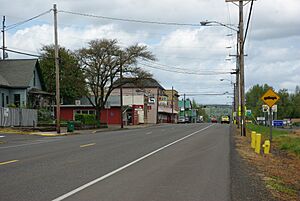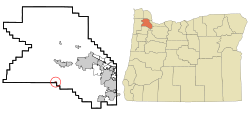Gaston, Oregon facts for kids
Quick facts for kids
Gaston, Oregon
|
|
|---|---|
 |
|

Location in Oregon
|
|
| Country | United States |
| State | Oregon |
| County | Washington |
| Incorporated | 1914 |
| Named for | Joseph Gaston |
| Area | |
| • Total | 0.34 sq mi (0.88 km2) |
| • Land | 0.34 sq mi (0.88 km2) |
| • Water | 0.00 sq mi (0.00 km2) |
| Elevation | 299 ft (91 m) |
| Population
(2020)
|
|
| • Total | 676 |
| • Density | 1,982.40/sq mi (764.43/km2) |
| Time zone | UTC-8 (Pacific) |
| • Summer (DST) | UTC-7 (Pacific) |
| ZIP code |
97119
|
| Area code(s) | 503 and 971 |
| FIPS code | 41-28100 |
| GNIS feature ID | 2410575 |
| Website | http://www.cityofgaston.com |
Gaston is a city in Washington County, Oregon, United States. It is located between the cities of Forest Grove to the north and Yamhill to the south. The city sits along Oregon Route 47 and borders the Tualatin River. Gaston is named after Joseph Gaston, who was a railroad executive. In 2020, the city had a population of 676 people.
Contents
History of Gaston
The first known people to live in the Tualatin Valley were the Atfalati tribe, who were part of the Kalapuya group. When Europeans arrived in the late 1700s, diseases like smallpox spread, which greatly reduced the Atfalati population.
In 1851, as more white settlers moved into the area, the remaining members of the tribe tried to make a deal with the Oregon Territory government. They offered their ancestral lands in the Tualatin Valley in exchange for a small reservation near Wapato Lake. However, this agreement was never officially approved. In the late 1850s, the U.S. government moved the tribe to the Grand Ronde Reservation.
Early Settlement and Railroad
Many American settlers began moving to the region in the 1850s. This was due to the Donation Land Claim Act, a law that gave land to white settlers who moved to the Oregon Territory before 1855.
In the 1870s, the West Side Railroad was built from Hillsboro to Corvallis. This railroad passed through the area where Gaston is now. The community of Gaston grew from being just a railroad stop in 1872 to an important business center. It soon had a school, a post office, a hotel, and a blacksmith shop.
Joseph Gaston, who the city is named after, left his job at the railroad in 1880 due to legal problems. He moved to the region and spent the next 16 years trying to drain Wapato Lake to create farmland.
Growth and Incorporation
The nearby community of Cherry Grove was started in 1911 as a place for logging. For a short time, it was even bigger than Gaston. However, Gaston was officially made a city in 1914. By 1916, the town had a general store, a bank, and other businesses.
In May 1935, workers at the Stimson Mill went on strike. People from Portland came to support the strikers. The next morning, Oregon's governor, Charles Martin, sent the state police and National Guard to protect other workers. The military and police, who had gas grenades and machine guns, told the strikers to leave or they would be shot. The strikers chose to leave, which prevented a dangerous situation.
New High School
In 1915, a new high school was built on land that Joseph Gaston had set aside for a school. This high school was used until the 1986–87 school year, when it was declared unsafe.
The closing of the building became a big issue for the town. Residents had to decide whether to join a nearby school district (like Forest Grove or Yamhill) or build a new high school. In the end, a new high school was built. This allowed Gaston to keep its own independent school system, which helped the town maintain its local pride. Today, the Gaston School District serves students from kindergarten through 12th grade, with a single high school.
Modern Expansion
The increasing popularity of Portland and the Pacific Northwest has led to more people moving to the region. At first, Gaston was too far from Portland to see much growth. However, recently, Gaston has started to see new homes being built and more students enrolling in its schools.
In the late 1980s, a new fire station was built. In the 1990s, a park for baseball and softball was created. Just after 2000, a new post office was built on the edge of town. So far, the town has not fully benefited from the growing popularity of the local wine industry. In 2006, the mayor suggested getting money from the state or federal government to improve the main business area on Main Street. This could help the city attract some of the money from wine tourism.
In 2008, the U.S. Fish and Wildlife Service began buying land in the Wapato Lake area. Their goal is to bring back the historic wetland that used to be there.
Geography
According to the United States Census Bureau, the city of Gaston covers a total area of about 0.28 square miles (0.72 square kilometers), and all of it is land.
Climate
Gaston has warm, but not hot, and dry summers. The average monthly temperatures do not go above 71.6°F (22°C). According to the Köppen Climate Classification system, Gaston has a warm-summer Mediterranean climate. This type of climate is often called "Csb" on climate maps.
Demographics
| Historical population | |||
|---|---|---|---|
| Census | Pop. | %± | |
| 1920 | 221 | — | |
| 1930 | 227 | 2.7% | |
| 1940 | 333 | 46.7% | |
| 1950 | 368 | 10.5% | |
| 1960 | 320 | −13.0% | |
| 1970 | 429 | 34.1% | |
| 1980 | 471 | 9.8% | |
| 1990 | 563 | 19.5% | |
| 2000 | 600 | 6.6% | |
| 2010 | 637 | 6.2% | |
| 2020 | 676 | 6.1% | |
| U.S. Decennial Census | |||
2010 Census Information
In 2010, the census showed that 637 people lived in Gaston. There were 241 households and 160 families. The city had about 2,275 people per square mile (878.4 people per square kilometer).
Most of the people living in Gaston were White (91.2%). Other groups included African American (0.3%), Native American (1.4%), Asian (0.6%), and Pacific Islander (0.2%). About 3.3% of the population identified as being from other races, and 3.0% were from two or more races. People who identified as Hispanic or Latino made up 11.0% of the population.
In the households, 36.9% had children under 18 living with them. About half (49.8%) were married couples living together. The average household had 2.64 people, and the average family had 3.18 people.
The average age in the city was 35.2 years old. About 26.7% of residents were under 18, and 6% were 65 years or older. The population was almost evenly split between males (51.2%) and females (48.8%).
Notable People
- Roddy Piper, a professional wrestler
Images for kids
See also
 In Spanish: Gaston (Oregón) para niños
In Spanish: Gaston (Oregón) para niños




